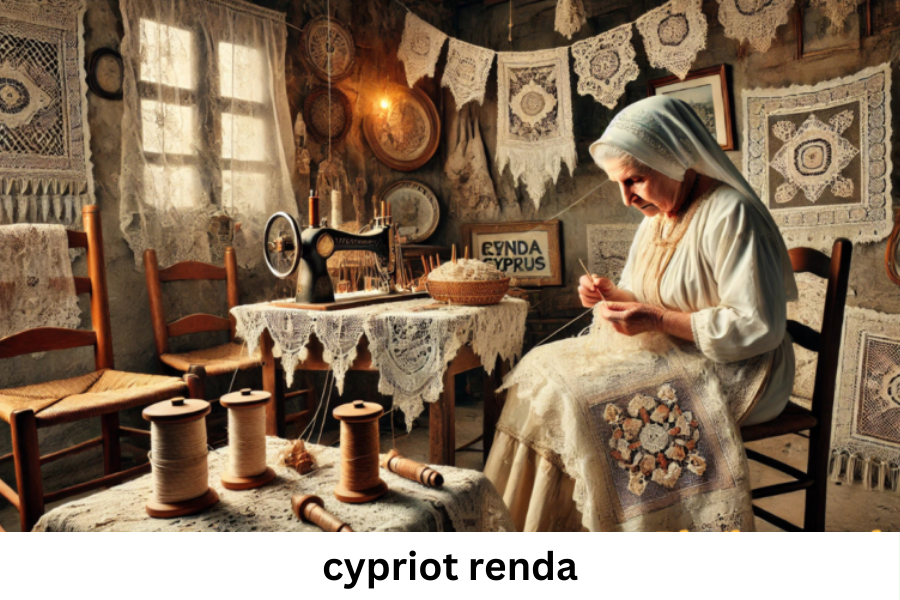Cypriot Renda, often referred to as Lefkara Lace, is an intricate form of embroidery that originates from the village of Lefkara in Cyprus. This traditional craft is renowned for its delicate designs, geometric patterns, and timeless beauty, earning a place in UNESCO’s Representative List of the Intangible Cultural Heritage of Humanity.
A Glimpse into Its History
The origins of Cypriot Renda can be traced back centuries, deeply embedded in the cultural and social fabric of Cyprus. Historical records suggest that Lefkara Lace gained prominence during the Venetian rule of the island (1489–1571). Venetian nobles, impressed by the intricate craftsmanship, influenced the embroidery techniques, blending local artistry with European aesthetics.
One fascinating tale from this period involves none other than Leonardo da Vinci. It is said that during his visit to Lefkara in 1481, da Vinci purchased a piece of lace, which he later gifted to the Milan Cathedral as an altar cloth. While the story’s authenticity has been debated, it highlights the historical significance and far-reaching influence of Cypriot Renda.
Before Venetian influence, the lace-making tradition existed as “asproploumia,” or white embroidery. Women meticulously worked on these pieces using basic tools, passing down their knowledge through generations. Over time, the craft evolved into the highly detailed and sophisticated art form we recognize today.
Wiki
| Aspect | Details |
| Name | Cypriot Renda (Lefkara Lace) |
| Origin | Lefkara village, Cyprus |
| Historical Significance | Rooted in Cyprus’ cultural heritage, influenced by Venetian rule and centuries-old traditions |
| Recognition | UNESCO Representative List of the Intangible Cultural Heritage of Humanity (2009) |
| Craftsmanship | Intricate embroidery combined with cutwork and satin stitching |
| Common Patterns | Geometric shapes (e.g., diamonds, triangles, zigzags), spirals (gyroulota), rivers (potamoi) |
| Materials Used | Cotton or linen fabric, needle, thread |
| Traditional Uses | Wedding dowries, tablecloths, curtains, household decorations |
| Modern Uses | Fashion accessories (scarves, dresses), home décor, and framed art |
| Cultural Importance | Symbol of Cyprus’ craftsmanship and cultural identity, vital for local economy |
| Notable Historical Figures | Leonardo da Vinci (allegedly purchased Lefkara Lace for Milan Cathedral) |
| Current Preservation Efforts | Workshops, educational programs, government initiatives to revive the craft |
| UNESCO Status | Added to UNESCO’s Intangible Cultural Heritage list in 2009 |
The Techniques Behind Lefkara Lace
The production of Cypriot Renda is a labor-intensive process requiring exceptional skill and patience. Traditionally, it begins with a cotton or linen base fabric, which is stretched taut before the embroidery work begins. The designs incorporate several unique stitches and patterns, often inspired by nature and geometry.
Key Features of Cypriot Renda:
- Geometric Patterns: The lace is known for its symmetrical, geometric designs, such as diamonds, zigzags, and triangles.
- Cutwork: Small sections of fabric are cut away to create intricate openwork patterns, known as “koptides.”
- Satin Stitch Fillings: Areas within the patterns are filled with satin stitches, adding texture and depth to the design.
- Needlepoint Edging: The edges are finished with precise needlework to create a seamless look.
Some of the most famous patterns include “potamoi” (rivers), which feature zigzag lines representing flowing water, and “gyroulota,” inspired by spirals and circular shapes. Each motif tells a story, reflecting the creativity and cultural heritage of the craftswomen.
The Cultural Importance of Cypriot Renda
Lefkara Lace holds immense cultural significance in Cyprus, serving as both a practical and symbolic artifact. Historically, it was a crucial element of a bride’s dowry. Families would proudly display collections of lace during weddings, showcasing their skill and wealth.
This tradition of lace-making was not just a hobby but also a source of income. Women often worked from home, selling their pieces to local markets or traveling merchants. Meanwhile, men from Lefkara traveled abroad to promote and sell these exquisite works of art, bringing global attention to the craft.
The lace’s reputation grew to such an extent that it became a popular souvenir among tourists. Its global appeal cemented Lefkara’s place as a hub for artistic excellence, ensuring the tradition remained alive despite the passage of time.
UNESCO Recognition
In 2009, UNESCO recognized Lefkara Lace as an important cultural heritage of humanity. This recognition highlighted the importance of preserving this unique tradition and the role it plays in the cultural identity of Cyprus.
The listing also brought renewed interest to the craft, encouraging younger generations to learn and continue the lace-making tradition. Schools and workshops now offer lessons, ensuring that this ancient art form is passed down to future artisans.
Modern Adaptations
While Cypriot Renda remains a traditional craft, its designs have been adapted to suit modern tastes and uses. Today, Lefkara Lace is not just used for tablecloths and curtains but also for fashion items like scarves, dresses, and accessories.
Designers and artisans have found innovative ways to incorporate this timeless art into contemporary home decor. For example, lace patterns are being used in wall hangings, cushion covers, and even framed as standalone pieces of art. This evolution has helped keep the craft relevant in today’s world, attracting a broader audience.
The Role of Craftswomen
The art of making Lefkara Lace is predominantly practiced by women. For centuries, it has been a source of empowerment, providing financial independence and a sense of pride. The lace-making process often involves hours of intricate work, requiring not only technical skill but also an artistic eye for detail.
In many cases, the knowledge and techniques are passed down through generations within families. Mothers teach their daughters the art of lace-making, ensuring the continuity of this valuable tradition. This generational transfer is a testament to the resilience and dedication of Cypriot women in preserving their cultural heritage.
The Economic Impact
Lefkara Lace has played a significant role in the local economy. The village of Lefkara, where the craft originates, has become a popular tourist destination, attracting visitors who wish to witness the lace-making process firsthand.
Craftswomen and local shops benefit from the steady stream of tourists, many of whom purchase these exquisite pieces as souvenirs. Additionally, international exhibitions and collaborations with designers have further boosted the demand for Lefkara Lace, contributing to the global recognition of Cypriot Renda.
Challenges in Preserving the Tradition
Despite its rich history and cultural significance, Lefkara Lace faces several challenges in the modern era. The rise of mass-produced textiles and the decline of traditional craftsmanship have posed a threat to the survival of this art form.
Younger generations, drawn to urban lifestyles and modern careers, are often reluctant to take up the craft. This shift has led to a decline in the number of skilled artisans, putting the future of Lefkara Lace at risk.
Efforts are being made to address these challenges through education and promotion. Workshops, exhibitions, and government initiatives aim to revive interest in the craft, ensuring its preservation for years to come.
The Global Appeal of Cypriot Renda
The intricate beauty of Lefkara Lace has captivated people worldwide. Its unique designs and craftsmanship have made it a sought-after item among collectors, art enthusiasts, and tourists.
International collaborations have further elevated its status. Designers and artists have incorporated Lefkara Lace into their work, showcasing its versatility and timeless appeal. This global recognition has not only boosted the craft’s popularity but also highlighted the rich cultural heritage of Cyprus on the world stage.
Cypriot Renda in Everyday Life
While Lefkara Lace is often associated with special occasions and decorative purposes, it also holds a place in everyday life. Many households in Cyprus continue to use lace tablecloths, curtains, and other items as a nod to their cultural roots.
In recent years, there has been a resurgence of interest in traditional crafts, with people seeking unique, handmade items that carry a sense of history and authenticity. This trend has contributed to the renewed appreciation for Cypriot Renda, ensuring its continued relevance in a fast-changing world.
Conclusion
Cypriot Renda, or Lefkara Lace, is not just a craft but a deep-rooted tradition that has survived for centuries. With its intricate designs and rich history, it remains a significant cultural symbol of Cyprus. From its origins in the village of Lefkara to its global recognition, this delicate lace embodies the artistry and creativity of Cypriot women who have passed down their skills through generations. Today, while the craft continues to be a cherished tradition, its adaptation to modern fashion and home décor ensures that it remains relevant in today’s world. As efforts to preserve and promote Lefkara Lace continue, it is clear that Cypriot Renda will endure as an essential part of Cyprus’ cultural heritage.
FAQs
1. What is Cypriot Renda?
Cypriot Renda, also known as Lefkara Lace, is a traditional form of handmade lace from Cyprus, renowned for its intricate designs and geometric patterns. It is created using a combination of embroidery and cutwork, resulting in delicate, detailed patterns.
2. Where does Cypriot Renda originate from?
Cypriot Renda comes from the village of Lefkara in Cyprus. This lace-making tradition dates back to at least the 14th century and has evolved through various cultural influences, including Venetian techniques.
3. Why is Cypriot Renda important?
Cypriot Renda holds cultural significance in Cyprus as it is a symbol of local heritage, tradition, and craftsmanship. Historically, it was an essential part of a bride’s dowry and has been a source of income for many Cypriot families. It was also added to UNESCO’s Representative List of Intangible Cultural Heritage of Humanity in 2009.
4. How is Cypriot Renda made?
Making Cypriot Renda involves an intricate process of embroidery, often using cotton or linen as a base fabric. Craftspeople use various stitches, including satin stitch fillings, and cutwork to create geometric patterns, often inspired by nature, and finalize them with delicate needlepoint edging.
5. What types of designs are common in Cypriot Renda?
The designs often feature geometric motifs such as zigzags, triangles, and diamonds, with popular patterns like “potamoi” (rivers) and “gyroulota” (spirals). These designs are usually symmetrical and demonstrate exceptional technical skill.
6. How is Cypriot Renda used today?
While traditionally used in tablecloths, curtains, and wedding dowries, Cypriot Renda is now also incorporated into modern home décor, clothing, and fashion accessories. Its timeless beauty makes it a sought-after item among collectors and art enthusiasts.
7. Is Cypriot Renda still being practiced?
Yes, Cypriot Renda continues to be practiced, especially in Lefkara and other villages in Cyprus. Though the number of skilled artisans has declined, efforts are being made through workshops and educational programs to preserve this traditional craft.
8. How can I learn to make Cypriot Renda?
If you’re interested in learning to make Cypriot Renda, many workshops in Cyprus and online platforms offer courses on lace-making techniques. It’s best to start by learning the basic stitches and gradually moving on to more complex patterns.
9. Can I buy Cypriot Renda online?
Yes, many shops and online marketplaces offer Cypriot Renda products, including tablecloths, scarves, and other lace items. Purchasing these items supports the preservation of this traditional craft and provides you with a beautiful piece of Cypriot heritage.
10. What makes Cypriot Renda unique?
Cypriot Renda stands out for its delicate craftsmanship, intricate design patterns, and cultural significance. Unlike mass-produced textiles, each piece of Cypriot Renda is handmade with exceptional attention to detail, making it a unique representation of Cypriot artistry.
Get the latest scoop and updates on playhop



